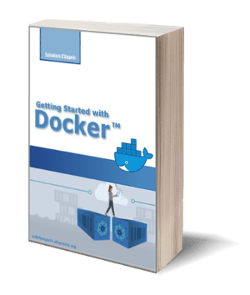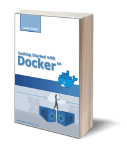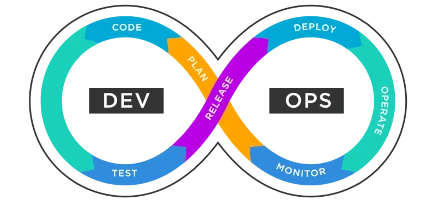
Bridging the Gap: Unleashing the Power of DevOps in Software Development
Posted on 06 Jun 2023
Introduction
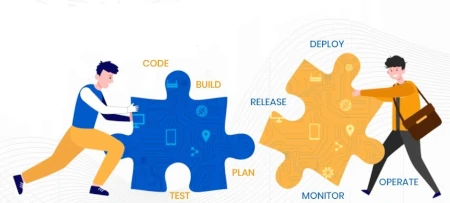
In the fast-paced world of software development, the need for efficient collaboration and seamless integration between development and operations teams has never been more critical. Traditionally, developers would spend months crafting code, only to hand it off to the quality assurance (QA) team for testing, before finally reaching the production environment, where an operations team would take over the management and support. Unfortunately, this siloed approach often led to limited collaboration, and issues encountered in production were resolved with difficulty, requiring modifications to the codebase.
The DevOps methodology was born to fill this gap. DevOps is an agile approach to organizational change that aims to bridge the traditional gaps between developer and IT operations roles. However, it is not simply a combination of developer, tester, and IT operation functions. DevOps represents a broader skill set and a fresh mindset that transcends the conventional silos of development, testing, and IT operations.
DevOps is one of the practices of Agile, operating at the practices level of the Agile Onion. It shares the Agile mindset, principles, and values with other Agile practices.
DevOps: Extending Agile Values with Automation, Continuous Integration and Deploy
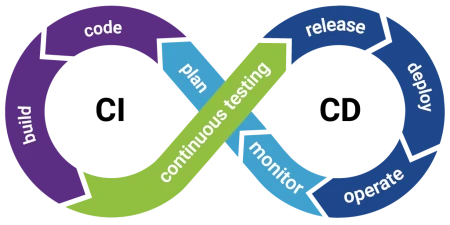
Photo from https://www.flagship.io
In the world of software development, the DevOps methodology brings forth a unique culture while aligning with the mindset, values, and principles of Agile. Building upon the insights shared in this article, DevOps introduces specific practices that address collaboration and integration challenges between development and operations teams.
Automation plays a pivotal role in DevOps, allowing organizations to streamline processes and eliminate manual bottlenecks. By automating tasks such as code testing, infrastructure provisioning, and deployment, DevOps fosters efficiency and reduces the risk of errors.
Continuous integration is a fundamental practice in DevOps, enabling development teams to regularly merge code changes into a shared repository. This approach promotes early identification of issues and facilitates collaboration among developers, ensuring a reliable and unified codebase.
DevOps also embraces Continuous Deployment, which automates the release of software changes directly into production environments. This practice empowers teams to rapidly respond to customer demands, validate new features, and swiftly incorporate feedback. By implementing a “You Build it, You Run it” principle, DevOps promotes shared responsibility, encouraging developers and operations teams to take ownership of the software throughout its lifecycle.
Through the adoption of these distinctive DevOps practices, complemented by the Agile mindset, values, and principles, organizations can achieve heightened efficiency, faster feedback loops, and improved collaboration across teams. Embracing automation, continuous integration, continuous deployment, and the sharing of responsibilities unlocks the full potential of DevOps and facilitates impactful software delivery.
Streamlining Efficiency and Scaling with Automation in DevOps

Photo from https://it.fiverr.com
Automation lies at the heart of DevOps and plays a pivotal role in enabling organizations to scale seamlessly on large infrastructures. For many years, the IT industry relied on manual modifications and maintenance across development, testing, and production systems, leading to various challenges. These challenges include:
- configuration drift;
- difficulty in scaling on extensive infrastructures;
- managing disaster recovery scenarios;
- an increased risk of errors.
The fundamental idea behind automation is to eliminate repetitive tasks through the use of code, such as scripts or programs. While the initial effort required to create these automations should be considered, the benefits are substantial, particularly when operations are repeated frequently. Automation not only saves time but also ensures consistency and accuracy in executing tasks.
Furthermore, automation empowers continuous monitoring of systems, enabling timely notifications in case of malfunctions or security compliance breaches. By automating routine activities, DevOps teams can free up valuable time and resources, allowing system engineers and other team members to focus on more critical tasks.
For instance, consider the scenario where a system engineer is tasked with performing a backup of a system twice a day. Automating this process would bring significant benefits, enabling the system engineer to allocate time towards more strategic activities.
In the realm of IT infrastructure management, several recurring activities form the backbone of operations, including infrastructure and software provisioning, configuration management, application deployment, incident management, change management, and more. Over time, these challenges have prompted the development of specialized tools to streamline and address these complexities. DevOps teams leverage a range of powerful tools such as Chef, Puppet, Ansible, Terraform, and others to tackle these infrastructure hurdles head-on.
Streamlining Development and Ensuring Code Quality with Continuous Integration
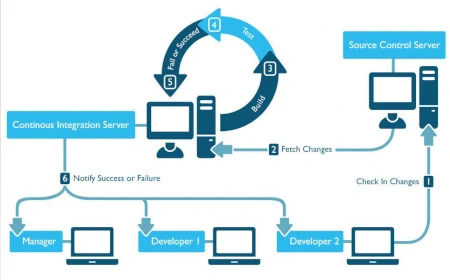
Photo from https://insights.sei.cmu.edu
Having worked as a software developer for over 30 years in large teams, I have experienced firsthand the challenges of maintaining a single repository as the single source of truth for code. Throughout the years, I have used various tools like CMVC, Rational Jazz, CVS, and eventually witnessed the rise of Git as the de facto standard for code management, with Linus Torvalds creating it specifically for managing the Linux codebase.
Today, Git is often complemented by its sibling, GitHub, which provides additional useful tools such as Wiki, collaboration features, and pull requests.
However, one of the most significant challenges has always been merging changes from dozens of developers and ensuring a functional system. I still remember the lengthy merge sessions that could last for weeks to integrate changes made by each developer.
Over time, Continuous Integration (CI) practices have emerged to address these challenges. The CI approach dictates that each developer works on their feature branch in Git, making incremental changes and attempting to break down larger features into smaller, manageable pieces that can be developed within one or two days. These changes are then submitted to the maintainer via pull requests for code review. Once the code is approved, it is merged into a single commit. Following this process, an automated build and test system kicks off, where a suite of tests validates the integrity of the produced code. Developers not only maintain the application code but also the code related to building and testing.
It’s important to note that this testing is primarily acceptance testing, which ensures that core functionalities continue to function correctly. It should not be confused with QA testing, which can also be automated and covers a broader range of scenarios.
In the realm of Continuous Integration, alongside Git and GitHub, several tools have emerged to automate the build and test processes. Popular tools like Jenkins, CircleCI, Travis, and many others have become essential components of the CI workflow, streamlining development, ensuring code quality, and enabling efficient collaboration among development teams.
Streamlined Delivery and Rapid Feedback Loops with Continuous Deployment
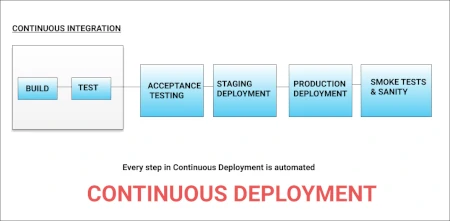
Photo from https://www.dotnettricks.com
Following the Continuous Integration phase, the software product becomes available to the QA team, which, in the world of DevOps, is typically the same team involved in development. The QA team is responsible for creating comprehensive test suites that cover a broader range of scenarios beyond the basic functionalities. From personal experience, achieving 100% test coverage with automated tests can be challenging, if not impossible, due to factors such as the difficulty of automation or time constraints. Consequently, it becomes necessary to have a subset of tests that are frequently executed under normal circumstances.
In the past, different phases of testing were commonly employed, including:
- functional tests;
- system tests (simulating real customer environments);
- performance tests for critical features;
- scalability tests;
- global verification tests for multiple language support.
Automation was often introduced to varying degrees within each testing phase, always considering the return on investment required to produce and maintain these test suites.
Moreover, with the advent of the Internet and the Cloud, the paradigm of product delivery to customers has shifted. Instead of selling products for customers to install in their own environments, companies now have the opportunity to offer products as Software as a Service (SaaS). As a result, the deployment process is managed directly by the product’s manufacturing company, utilizing dedicated operations teams.
The concept behind continuous deployment is that with every successful change passing through the build, verification, QA testing, and other stages, it can be automatically deployed across different environments, following a pipeline that includes development, staging, and production environments.
By implementing continuous deployment, even small changes can be quickly identified and any potential issues can be addressed promptly. This approach fosters a rapid feedback loop, allowing developers and operations teams to work closely together, detect problems early on, and make necessary corrections swiftly.
Essential Skills for Effective DevOps Engineering
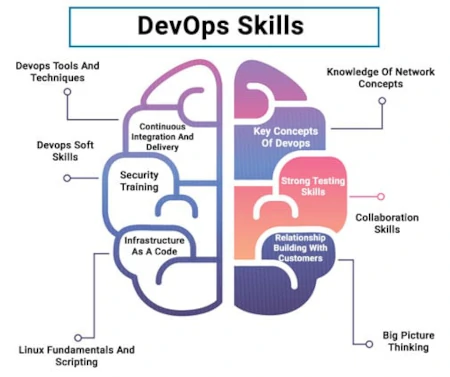
Photo from https://www.janbasktraining.com/
A successful DevOps engineer possesses a diverse skill set that enables them to navigate the complex landscape of infrastructure management, automation, and software delivery. Their proficiency in various technical domains is crucial for building robust and scalable systems. Let’s explore the key skills that a DevOps engineer should possess.
- Sysadmin Expertise:
A DevOps engineer must have strong system administration skills, encompassing both Unix and Windows environments. This knowledge is essential for building the infrastructure that will host the applications. While Infrastructure as Code (IaC) techniques automate infrastructure provisioning, the DevOps engineer must understand the underlying administration concepts to create effective automation scripts. Infrastructure construction is a highly automatable process, allowing quick recovery and recreation of resources when issues arise.
- Experience in Virtualization:
Managing cloud infrastructure often involves virtualization technologies such as OpenStack or VMWare. A DevOps engineer should be proficient in creating and managing virtual machines and understanding how they integrate with the overall infrastructure. Knowledge of virtualization is instrumental in efficiently utilizing hardware resources and optimizing infrastructure performance.
- Varied Technical Background:
A DevOps engineer should possess a diverse technical background, encompassing knowledge of virtualization, networking, storage systems, and more. This broad expertise allows them to design and implement reliable and resilient solutions. Understanding the underlying technologies and their interactions is crucial for creating robust architectures that can scale and adapt to evolving business needs.
- Proficiency in Programming and Scripting:
A strong command of programming and scripting languages is vital for a DevOps engineer. They must be able to leverage these skills to build infrastructure using technologies like YAML, Terraform, CloudFormation, and others. Additionally, they should be capable of developing applications using languages such as C, C++, Java, Python, PHP, JavaScript, and more.
- Experience with Automation Tools:
A DevOps engineer leverages tools like Git and GitHub to automate code management. Automation tools like CircleCI and Travis are widely used for implementing continuous integration and conducting build and acceptance testing. With robust testing pipelines in place, the DevOps engineer can ensure that every code change undergoes thorough testing, reducing the risk of introducing bugs and ensuring the overall quality of the software. DevOps engineers rely on a range of tools for efficient and automated application deployment. Platforms like Chef, Puppet, Jenkins, and Ansible offer powerful capabilities for managing infrastructure, configuring servers, and deploying applications across various environments.
-
Testing Skills: A DevOps engineer should possess competencies in testing methodologies and practices. While DevOps emphasizes continuous integration and delivery, it is essential to ensure the quality of the software being deployed. Familiarity with various testing techniques, such as unit testing, integration testing, and performance testing, enables the engineer to design and implement effective testing strategies. By incorporating testing into the CI/CD pipeline, they can validate the functionality and performance of applications, identify potential issues, and ensure a high level of software quality.
-
Team-First Mindset: Collaboration and teamwork are at the core of DevOps culture. A DevOps engineer should have a team-first mindset, emphasizing cooperation and effective communication within cross-functional teams. They should actively engage with developers, operations personnel, and other stakeholders to understand their requirements and challenges, fostering a collaborative and productive work environment. By promoting knowledge sharing, empathy, and a willingness to assist others, the DevOps engineer contributes to a cohesive and efficient team dynamic.
-
Strong Communication Skills: Effective communication is vital for a DevOps engineer to collaborate with team members, stakeholders, and clients. They should be able to clearly articulate complex technical concepts, listen actively, and provide concise and accurate information. By effectively communicating project status, challenges, and proposed solutions, the DevOps engineer ensures alignment and transparency across all parties involved. Additionally, their communication skills play a crucial role in documenting processes, sharing knowledge, and facilitating efficient problem-solving.
-
Creation of Resilient Infrastructures: A key responsibility of a DevOps engineer is to design and build resilient infrastructures. They should possess the ability to anticipate and address potential failures and bottlenecks, ensuring high availability and fault tolerance. Through the application of techniques such as redundancy, load balancing, and disaster recovery planning, the DevOps engineer strengthens the overall stability and reliability of the systems they manage. They should also have a deep understanding of monitoring and alerting systems to proactively identify and address performance issues.
DevOps is the Right Career for Me?
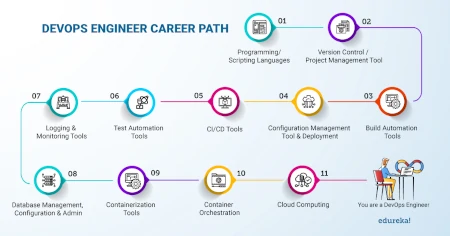
Photo from https://twitter.com/
If you possess strong coding skills, even if you don’t reach the level of a software engineer, and are willing to get your hands dirty by building both applications and infrastructure, then a career in DevOps may be a perfect fit for you. It requires a diverse skill set, as discussed earlier, and entails problem-solving abilities and adaptability to changing methodologies and technologies. Embracing automation is essential, and having a mindset geared towards streamlining and optimizing processes is crucial. Additionally, the ability to transcend the traditional silos of development, testing, and operations and work effectively in a team environment is highly valued by companies seeking DevOps engineers.
Choosing a career in DevOps means you’ll need to continuously study and update your knowledge to stay ahead in this rapidly evolving field. Pursuing certifications can be beneficial in showcasing your skills to potential employers or advancing your career. However, it’s important to note that certifications often represent only a fraction of the knowledge required for a particular methodology or tool. What truly matters is hands-on experience and the ability to solve problems using those tools effectively.
By continuously honing your skills and gaining practical experience, you can increase your chances of finding employment or advancing in your DevOps career. The demand for skilled DevOps professionals is consistently high, as organizations increasingly recognize the value of efficient and reliable software delivery processes. DevOps engineers play a critical role in bridging the gap between development and operations, improving collaboration, and enabling rapid and frequent software releases. As a result, career growth opportunities are abundant, and DevOps professionals often find themselves in high-demand positions within the industry.
Conclusion
Embarking on a career in DevOps can be an exciting and rewarding path for those who possess coding skills, a willingness to tackle infrastructure challenges, and a diverse technical skill set. DevOps engineers play a crucial role in bridging the gap between development and operations, fostering collaboration, and enabling efficient software delivery processes. Their ability to automate tasks, solve problems, and adapt to evolving methodologies and technologies is highly valued in today’s fast-paced IT landscape.
Employers seek professionals who can transcend the boundaries of traditional silos, work well in teams, and drive positive change within organizations. So, if you have a passion for coding, enjoy building infrastructure, possess problem-solving abilities, and are ready to embrace the ever-evolving nature of technology, DevOps may be the perfect career choice for you. Embrace the journey, nurture your skills, and embark on an exciting adventure at the forefront of software development and delivery.

